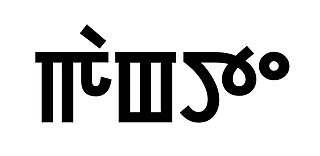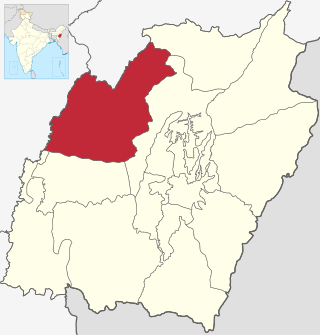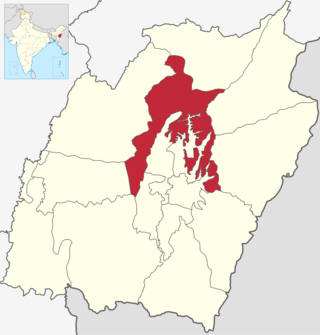
Gangte is an ethnic group residing predominantly in the Indian state of Manipur, as well as in parts of Mizoram, Assam, and Myanmar. Also part of the larger Zo people, and are recognized as a tribe in both Manipur and under the Indian Constitution. As of as of 2018, their global population is estimated to be approximately 40,000. Their primary settlements in India are located in Churachandpur district of Manipur and in neighboring states, including Meghalaya, Mizoram, and Assam. The Gangtes predominantly use the Meitei language as their second language (L2).
The Koireng people are one of the ethnic groups inhabiting Manipur in North-East India. They speak the [Koireng language]. They are mentioned in the Meitei royal chronicle Cheitharol Kumbaba in the year 1404, one of the oldest tribes to be so mentioned. They have a shared common ancestry, history, cultural traits, folklore and dialects with their kindred people like Aimol and Kom. They use Meitei language as their second language (L2) according to the Ethnologue.

Chandel district is one of the 16 districts of Manipur state in northeastern India. Its headquarters is the town of Chandel. In December 2016, a part of the district was split to establish the new Tengnoupal district. The district is mainly populated by Kuki-Zo and Old Kuki/Naga tribal people.

Senapati, is one of the 16 districts of the Indian state of Manipur. The present Senapati district was formed in December 2016, after spawning off the Sadar Hills region in the south into a separate Kangpokpi district. The district headquarter is located in the municipality of Tahamzam.

Tamenglong district is one of the 16 districts of Manipur state in northeastern India. In 2011, Tamenglong was the least populous district in Manipur. In 2016, the Nungba subdivision was separated as a separate district.

Ukhrul district is an administrative district of the state of Manipur in India with its headquarters at Ukhrul. The Ukhrul district has a long history dating back to the 1920s when it was created as the North-East Hill Sub-Division of the then princely state of Manipur. In 2016, the Kamjong subdivision of the Ukhrul district was spun out as a separate district, leading to the present configuration of the Ukhrul district.
Thadou, Kuki, or Thado Chin is a Sino-Tibetan language of the Northern Kuki-Chin sub-branch. It is spoken by the Thadou people in Northeast India. The speakers of this language use Meitei language as their second language (L2) according to the Ethnologue.

The Maram people, also known as the Maram Naga, are a Tibeto-Burmese Naga ethnic group inhabiting the large portion of Senapati district in the Northeast Indian state of Manipur. They use Meitei language as their second language (L2) according to the Ethnologue.

The Kabui people, are a Tibeto-Burman indigenous ethnic group in the Northeast Indian state of Manipur.They are recognised as a scheduled tribe (STs) by the Constitution of India. They use Meitei language as their second language (L2) according to the Ethnologue.
The Kom people are one of the indigenous ethnic Kuki groups, who had settled in Manipur. They share very similar traditional attires and surnames with Lamkang.The Kom tribes have Karong, Serto, Leivon and Tellien clans etc.They are mainly found in Manipur of North-East India. They use Meitei language as their second language (L2) according to the Ethnologue.

The Chothe people is one of the Naga ethnic group found in the state of Manipur, India. Some historians and anthropologists have erroneously recorded the Chothe as the Purum of India. They are listed as a Scheduled Tribe, in accordance with The Scheduled Castes and Scheduled Tribes Orders (Amendment) Act, 1976 Indian Constitution. They use Meitei language as their second language (L2) according to the Ethnologue.

Tangkhul is a Sino-Tibetan language of the Tangkhulic branch, spoken in different villages of Ukhrul district, Manipur, India. The term "Tangkhul" is derived from the Meitei language terms, "Tang" meaning "scarce" and "Khul" meaning "village" respectively. According to another theory, the term "Tangkhul" is derived from "Thankhul", meaning "Than village" in Meitei language.

Chiru (Naga) is a Southern Naga language spoken mostly in Manipur. The Chiru population numbers approximately 8,599. It is an endangered spoken in three districts of Manipur: Senapati, Noney district of Manipur and Cachar district of Assam. Chiru has been recognized as a Scheduled Tribe of Manipur by the government of India since 1956 under "The Scheduled Castes and Scheduled Tribes Orders (Amendment) Act, Act No. 63 of 1956" Dated 25 September 1956. The total population of the native speakers of Chiru is only 8599. The native speakers have high proficiency in Meitei language. The language is neither used in schools nor in radio or mass media. Older people read and write in Meitei language. The younger generation of Chiru speakers prefers Roman script. The speakers of this language use Meitei language as their second language (L2) according to the Ethnologue.

Aimol, also known as Aimual, is a Sino-Tibetan language spoken by the Aimol people of Manipur, India. It is considered endangered and has less than 9,000 speakers worldwide as per 2011 census. The speakers of this language use Meitei language as their second language (L2) according to the Ethnologue.

Purum is a Southern Naga language of India. Speakers consider themselves to be ethnic Naga people, rather than part of the Kuki and Chin ethnic groups. Peterson (2017) classifies Purum as part of the Northwestern branch of Kuki-Chin. According Ethnologue, Purum shares a high degree of mutual intelligibility with Kharam. The speakers of this language use Meitei language as their second language (L2) according to the Ethnologue.

Kharam is a Southern Naga language of India. Peterson (2017) classifies the closely related Purum language as part of the Northwestern branch of Kuki-Chin. According Ethnologue, Kharam shares a high degree of mutual intelligibility with Purum. The speakers of this language use Meitei language as their second language (L2) according to the Ethnologue.

Kangpokpi district is one of the 16 districts in the Indian state of Manipur. It was created in December 2016 from areas in the Sadar Hills region which were previously part of Senapati District.

Chiru people is a Zo ethnic group that mostly resides in Manipur and some in Assam, India. They are listed as a Scheduled Tribe, in accordance with The Scheduled Castes and Scheduled Tribes Orders (Amendment) Act, 1976 Indian Constitution. They use Meitei language as their second language (L2) according to the Ethnologue.
Meitei language, the sole official language and the lingua franca of Manipur, one of the scheduled languages of India, one of the recognised educational and literary languages of Assam and Tripura states, has its speakers spread across entire India.
The Khamenlok clash occurred during 12–14 June 2023, in the course of 2023–2024 Manipur violence between the Meitei and Kuki people, in the Khamenlok river valley, a branch valley of the Iril River valley, in the Saikul subdivision of Kangpokpi district. An estimated mob of 3,000 Meitei assailants, some with sophisticated weapons, launched an attack on the Kuki villages in the Khamenlok valley, over a period of three days, burning houses and rampaging the area. While the Kuki villagers escaped to the hills on arrival of the assailants, the security forces were blocked from reaching the area by women activist groups. Finally, on 13 June, while the assailants were celebrating in a church building, the Kuki village defence volunteers descended from the hills and carried out a wholesale massacre of the Meitei mobs. The official death count was nine people, but unofficial estimates were in excess of 200 people.















